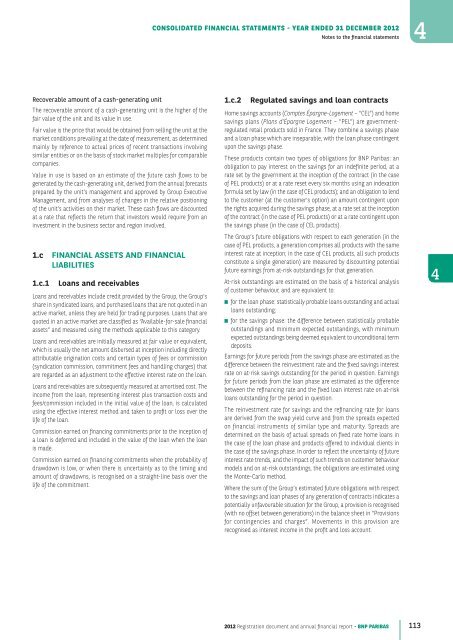2012 Registration document and annual financial report - BNP Paribas
2012 Registration document and annual financial report - BNP Paribas
2012 Registration document and annual financial report - BNP Paribas
- No tags were found...
You also want an ePaper? Increase the reach of your titles
YUMPU automatically turns print PDFs into web optimized ePapers that Google loves.
CONSOLIDATED FINANCIAL STATEMENTS - YEAR ENDED 31 DECEMBER <strong>2012</strong>Notes to the <strong>financial</strong> statements4Recoverable amount of a cash-generating unitThe recoverable amount of a cash-generating unit is the higher of thefair value of the unit <strong>and</strong> its value in use.Fair value is the price that would be obtained from selling the unit at themarket conditions prevailing at the date of measurement, as determinedmainly by reference to actual prices of recent transactions involvingsimilar entities or on the basis of stock market multiples for comparablecompanies.Value in use is based on an estimate of the future cash flows to begenerated by the cash-generating unit, derived from the <strong>annual</strong> forecastsprepared by the unit’s management <strong>and</strong> approved by Group ExecutiveManagement, <strong>and</strong> from analyses of changes in the relative positioningof the unit’s activities on their market. These cash flows are discountedat a rate that reflects the return that investors would require from aninvestment in the business sector <strong>and</strong> region involved.1.c FINANCIAL ASSETS AND FINANCIALLIABILITIES1.c.1Loans <strong>and</strong> receivablesLoans <strong>and</strong> receivables include credit provided by the Group, the Group’sshare in syndicated loans, <strong>and</strong> purchased loans that are not quoted in anactive market, unless they are held for trading purposes. Loans that arequoted in an active market are classified as “Available-for-sale <strong>financial</strong>assets” <strong>and</strong> measured using the methods applicable to this category.Loans <strong>and</strong> receivables are initially measured at fair value or equivalent,which is usually the net amount disbursed at inception including directlyattributable origination costs <strong>and</strong> certain types of fees or commission(syndication commission, commitment fees <strong>and</strong> h<strong>and</strong>ling charges) thatare regarded as an adjustment to the effective interest rate on the loan.Loans <strong>and</strong> receivables are subsequently measured at amortised cost. Theincome from the loan, representing interest plus transaction costs <strong>and</strong>fees/commission included in the initial value of the loan, is calculatedusing the effective interest method <strong>and</strong> taken to profit or loss over thelife of the loan.Commission earned on financing commitments prior to the inception ofa loan is deferred <strong>and</strong> included in the value of the loan when the loanis made.Commission earned on financing commitments when the probability ofdrawdown is low, or when there is uncertainty as to the timing <strong>and</strong>amount of drawdowns, is recognised on a straight-line basis over thelife of the commitment.1.c.2Regulated savings <strong>and</strong> loan contractsHome savings accounts (Comptes Épargne-Logement – “CEL”) <strong>and</strong> homesavings plans (Plans d’Épargne Logement – “PEL”) are governmentregulatedretail products sold in France. They combine a savings phase<strong>and</strong> a loan phase which are inseparable, with the loan phase contingentupon the savings phase.These products contain two types of obligations for <strong>BNP</strong> <strong>Paribas</strong>: anobligation to pay interest on the savings for an indefinite period, at arate set by the government at the inception of the contract (in the caseof PEL products) or at a rate reset every six months using an indexationformula set by law (in the case of CEL products); <strong>and</strong> an obligation to lendto the customer (at the customer’s option) an amount contingent uponthe rights acquired during the savings phase, at a rate set at the inceptionof the contract (in the case of PEL products) or at a rate contingent uponthe savings phase (in the case of CEL products).The Group’s future obligations with respect to each generation (in thecase of PEL products, a generation comprises all products with the sameinterest rate at inception; in the case of CEL products, all such productsconstitute a single generation) are measured by discounting potentialfuture earnings from at-risk outst<strong>and</strong>ings for that generation.At-risk outst<strong>and</strong>ings are estimated on the basis of a historical analysisof customer behaviour, <strong>and</strong> are equivalent to:■ for the loan phase: statistically probable loans outst<strong>and</strong>ing <strong>and</strong> actualloans outst<strong>and</strong>ing;■ for the savings phase: the difference between statistically probableoutst<strong>and</strong>ings <strong>and</strong> minimum expected outst<strong>and</strong>ings, with minimumexpected outst<strong>and</strong>ings being deemed equivalent to unconditional termdeposits.Earnings for future periods from the savings phase are estimated as thedifference between the reinvestment rate <strong>and</strong> the fixed savings interestrate on at-risk savings outst<strong>and</strong>ing for the period in question. Earningsfor future periods from the loan phase are estimated as the differencebetween the refinancing rate <strong>and</strong> the fixed loan interest rate on at-riskloans outst<strong>and</strong>ing for the period in question.The reinvestment rate for savings <strong>and</strong> the refinancing rate for loansare derived from the swap yield curve <strong>and</strong> from the spreads expectedon <strong>financial</strong> instruments of similar type <strong>and</strong> maturity. Spreads aredetermined on the basis of actual spreads on fixed rate home loans inthe case of the loan phase <strong>and</strong> products offered to individual clients inthe case of the savings phase. In order to reflect the uncertainty of futureinterest rate trends, <strong>and</strong> the impact of such trends on customer behaviourmodels <strong>and</strong> on at-risk outst<strong>and</strong>ings, the obligations are estimated usingthe Monte-Carlo method.Where the sum of the Group’s estimated future obligations with respectto the savings <strong>and</strong> loan phases of any generation of contracts indicates apotentially unfavourable situation for the Group, a provision is recognised(with no offset between generations) in the balance sheet in “Provisionsfor contingencies <strong>and</strong> charges”. Movements in this provision arerecognised as interest income in the profit <strong>and</strong> loss account.4<strong>2012</strong> <strong>Registration</strong> <strong>document</strong> <strong>and</strong> <strong>annual</strong> <strong>financial</strong> <strong>report</strong> - <strong>BNP</strong> PARIBAS 113





